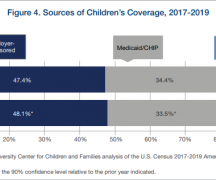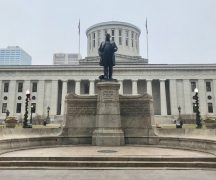The long-awaited coronavirus vaccine is expected to begin flowing into Ohio in about three weeks, but state officials worry that the coming holidays will act as gasoline on a pandemic that is already burning out of control.
For caregivers already stressed by the demands the virus has placed on them, the coming weeks are critical.
“We are overworked, exhausted and tired,” said Jasmine Shavers, a nurse in an all-covid intensive-care unit at Dayton’s Miami Valley Hospital. “We’re trying our best, but covid is no joke.”
Gov. Mike DeWine invited Shavers to speak during his coronavirus press conference in an attempt to get Ohioans to take seriously the worsening news about the pandemic.
“Our challenge is that the whole northern part of the country is red hot,” DeWine said of the spread of the virus. With the rate of infections among those tested in Ohio approaching 14%, DeWine said he’s on the brink of warning out-of-staters not to come here.
A partial accounting of new cases on Tuesday showed 8,133 over the previous 24 hours. Also, the number of those hospitalized and the number of covid patients in intensive care remained high, said Bruce Vanderhoff, chief medical officer for the Ohio Department of Health.
“Anytime you have a single diagnosis that’s occupying 20% of the beds in your hospital… that’s unheard of,” he said.
He, DeWine and other health officials pushed again on Tuesday to get people to avoid gathering for Thanksgiving and other celebrations at a time when cold, damp weather is pushing people indoors.
Vanderhoff said part of the current surge could be tied to Halloween gatherings and it’s “putting incredible pressure on our hospitals.”
He added the the coming holiday could hold a far worse result.
“Thanksgiving could have a much bigger impact and result in our hospitals being overwhelmed,” Vanderhoff said.
Help appears to be on the way, however.
DeWine said that his team has been told that around Dec. 15, Ohio will receive a first batch of about 30,000 vaccine doses from drugmaker Pfizer. It will be followed a week later with a batch from Moderna, whose vaccine has also shown promise in clinical trials.
“We’re told that once it starts coming, they hope it will be a continuous flow,” DeWine said.
A course of the vaccines will require two doses over three to four weeks, so tens of thousands of doses won’t go far in a state of nearly 12 million.
State officials will work with federal authorities in setting priorities for who gets the vaccine first. DeWine said that health professionals in direct contact with covid patients and those who work with people in settings such as nursing homes likely will be among those at the front of the line.
But until they can be vaccinated, they’re at the mercy of their neighbors.
Stephanie Marshall, a respiratory therapist at Grant Hospital in Columbus, said she didn’t know if she caught coronavirus there or somewhere else, but she said it was terrifying.
She described mild symptoms earlier this month that then intensified, resulting in a two-day hospital stay.
“I was home for two days and then I got really bad,” Marshall, 37, said, describing how she developed pneumonia in both lungs.
Her husband drove with her to the hospital, but had to leave her at the emergency room doors because of covid restrictions.
“I didn’t know if it was the last time I would ever see them,” she said of her husband and two small children.
After seven more days in the hospital — during which she begged to be kept off a ventilator — she’s back home as a “long hauler,” breathing supplemental oxygen as her respiratory system fights a long battle to recover.
As Marshall told her story during the governor’s press conference, DeWine’s Twitter feed continued to stream with comments minimizing the severity of the disease and questioning the need to take precautions against it.
What would Marshall say to them?
“We see patients come into our hospital in their 20s and 30s with no underlying health problems,” she said. “They talk to us and then within hours they’re dead. This is not something to mess around with. It’s a very serious virus, but unless you’ve watched people die from it, it’s really hard to see the full effects of it.”
***
Teachers unions urge veto on school funding bill
Two of Ohio’s top teachers unions are asking the governor to veto a new education bill just passed by the legislature.
The Ohio Senate and House passed Senate Bill 89 (cosponsored by State Sen. Theresa Gavarone and State Rep. Haraz Ghanbari) last week after it spent months in a conference committee being revised and developed into a bill that, among other things, focuses on the private school voucher program, EdChoice.
The bill passed along partisan lines in both houses of the legislature, with Republican supporters saying the bill was necessary to keep the list of EdChoice eligible schools from ballooning to more than 1,200, and to address one of the biggest barriers to education — poverty.
Democrats challenged the idea that the bill was a solution to the state’s problems, and accused supporters of pushing the bill through without the appropriate amount of public input. READ MORE
Immigration advocates push Biden to not just bring back DACA but expand it
WASHINGTON — President-elect Joe Biden is promising to reinstate an Obama-era program that shields deportation for some undocumented people who were brought to the United States by their parents when they were children.
But immigration advocates are pushing for the Deferred Action for Childhood Arrivals program to not just be reaffirmed but expanded, and written into law. They view that as a minimum goal in immigration policy, with deportation protection for DACA recipients’ family members extended as well.
“During the Trump administration we’ve seen how fragile the program is and how easily it can be taken away,” said Krsna Avila, a staff attorney at the Immigrant Legal Resource Center. President Donald Trump tried to dismantle DACA, but earlier this year was thwarted by the Supreme Court.
While the largest numbers of those enrolled in DACA live in California, Illinois and Texas, they are scattered across the nation. Some states with large numbers of DACA recipients include Florida, Colorado, Georgia, North Carolina, Nevada and Arizona, according to data from the U.S. Citizenship and Immigration Services and the 2016 Census.





